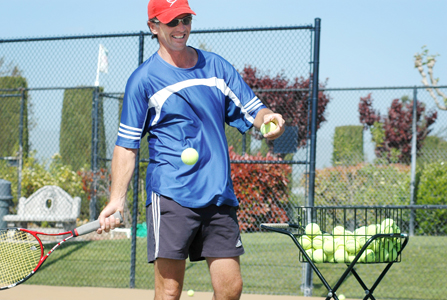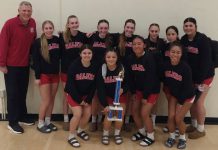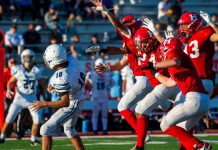
Tennis coach takes a circuitous route back to a youthful
passion
He coached Gilroy High to its last league boy’s tennis title.
He’s been at helm of Live Oak’s tennis program for the last two
years and has had a hand in developing just about every top junior
tennis player in the area since moving to Morgan Hill in 1999.
Now Chris Yoder would like to build up his clientele in the
Hollister area, which is why the tennis professional jumped at the
offer to become the head pro and tennis director at Ridgemark
Country Club last fall.
Tennis coach takes a circuitous route back to a youthful passion
He coached Gilroy High to its last league boy’s tennis title. He’s been at helm of Live Oak’s tennis program for the last two years and has had a hand in developing just about every top junior tennis player in the area since moving to Morgan Hill in 1999.
Now Chris Yoder would like to build up his clientele in the Hollister area, which is why the tennis professional jumped at the offer to become the head pro and tennis director at Ridgemark Country Club last fall.
Yoder’s road to becoming a tennis pro is an interesting one. As a child growing up in Wichita, Kan., Yoder was first introduced to the game by his dad, who was an avid recreational player.
“I played in tons of junior tournaments as a kid,” said Yoder, who graduated from Wichita Southeast High School in 1982. “I got real serious with it about the time I was a freshman in high school. But I also liked to do other weird stuff like hunting and fishing and riding dirt bikes.”
As quickly as he got interested in tennis is almost as quickly as he got out of it. After high school Yoder went on to attend the University of Kansas where he earned a bachelor’s degree in communications. While in college Yoder put his racquet down in order to play ultimate Frisbee for the Jayhawk’s club team.
“I didn’t think I was good enough to go pro back then,” Yoder said. “I didn’t foresee myself going on the pro tour and making a living at it.”
So Yoder took what he describes as a “seven-year sabbatical” from the sport in order to focus on ultimate Frisbee, which was similar playing football only with the use of the flying disc. After graduating in 1987, Yoder, an avid snow skier as well, decided to pack up his belongings and head west. In 1988 he landed in Lake Tahoe where he could ski under some of the best conditions in the world before moving to Santa Cruz just a few months before the infamous Loma Prieta earthquake struck the region.
“When the quake hit I was playing ultimate Frisbee at UC-Santa Cruz,” Yoder said.
While in Santa Cruz Yoder was hanging out and deciding what career path would be best for the communications major to take. One afternoon, he overheard a local tennis pro saying that he was in need of a fulltime assistant, who could help him out at the La Madrona Swim and Racquet Club in Scotts Valley.
That’s when the lights came on.
“Tennis allowed me to blend my communication skills with my desire to work outdoors and stay active,” he said. “Tennis really answered the question for me.”
Although it had been a long time since he had competed, Yoder proved that he still had enough skills to become a certified instructor and received his credentials from the United States Professional Tennis Association in 1990. For the next five years, Yoder taught at La Madrona. By 1993, he was getting so well known in the community that he was offered the head-coaching job at Soquel High School where he coached for two years.
In the spring of 1995, Yoder left the Santa Cruz area and came east over Highway 17 where he settled in at the Los Gatos Swim and Racquet Club. It was during his four-year stint there where he met his wife, Jennifer, who was working in the club’s fitness area.
Although Yoder enjoyed his time in Los Gatos as an assistant pro, head pro and tennis director, he decided to break away from the club in order to start his own teaching business in Morgan Hill.
“I had 10 years of club experience and just decided that I wanted to start my own program,” said Yoder.
In Morgan Hill Yoder was able to teach his clients at their own homes and at public courts in the area as well as renting out courts at Live Oak High School for lessons. Between lessons Yoder also found the time to coach the sport at the high school level and did so for a few years at Gilroy High before coming to Live Oak when the position opened up two years ago.
In recent years both he and his wife, who also is a tennis professional, have also taught the junior tennis program at Morgan Hill’s Community Park. Out of that program, he has assembled a number of competitive junior club travel teams as well.
Today, his students range in age from 5 to 75 – and they’re all unique.
“Every player is different. I assess every player to find out what their individual needs and goals are,” he said. “I identify what they want and then start from there.”
Regardless of skill level, one of the most common flaws that he sees time and time again with students is their failure to look at the ball when they hit it.
“That happens all the time, even with top players,” Yoder said. “They look where they want to hit the ball instead of making good contact first.”
Despite the challenges of teaching, it’s a job that Yoder wouldn’t trade with anyone.
“I enjoy helping other people and working with other people,” Yoder said. “I like helping them improve their game, and I enjoy introducing the sport to new players.”
The last two years he has coached both the boys and girls tennis teams at Live Oak and has been both the head tennis pro and director of tennis at Ridgemark since assuming the position last October.
“It’s awesome,” Yoder said. “The facility has great potential.”
Over the years Yoder has worked with a number of junior players that have gone on to attain high rankings in Northern California. Yoder enjoys watching the development of his young players and how their improved tennis skills often roll over into other avenues of life.
“When the kids improve, their confidence and self-esteem builds up,” he said.
Although he’s been teaching the sport for years, Yoder says the most difficult thing to do is project how a young talented player will be down the road.
“You can’t tell right away because the most talented players can often take things for granted. And sometimes the player who might not be as gifted works a lot harder at it and ends up being better in the long run.”
In addition to teaching his younger students the proper fundamentals, Yoder likes to teach them to have respect for their opponents on the court as well as giving them a strong foundation on the rules of the game.









